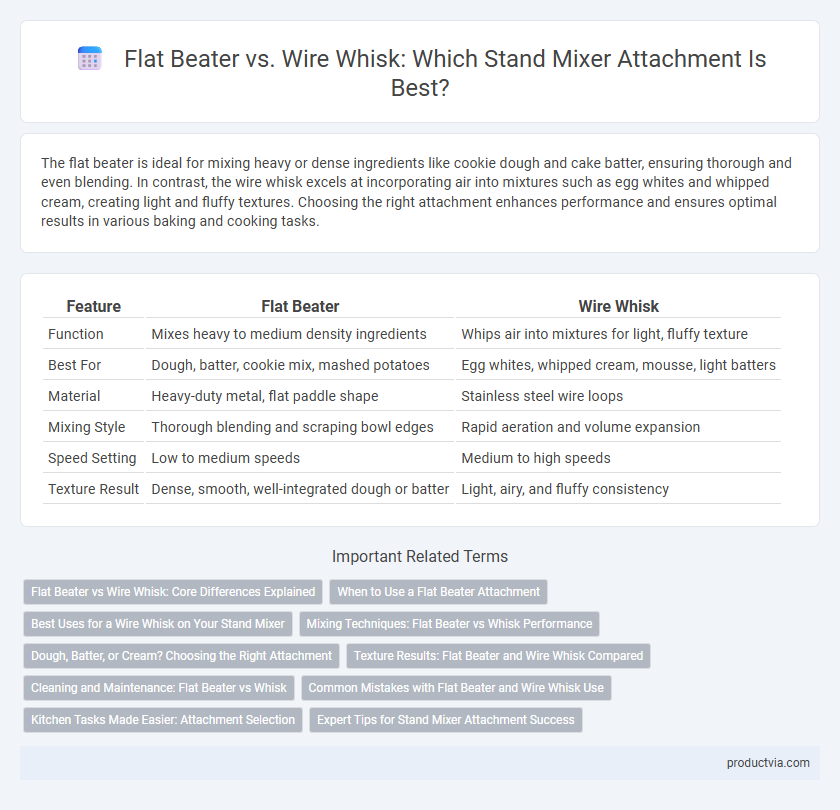The flat beater is ideal for mixing heavy or dense ingredients like cookie dough and cake batter, ensuring thorough and even blending. In contrast, the wire whisk excels at incorporating air into mixtures such as egg whites and whipped cream, creating light and fluffy textures. Choosing the right attachment enhances performance and ensures optimal results in various baking and cooking tasks.
Table of Comparison
| Feature | Flat Beater | Wire Whisk |
|---|---|---|
| Function | Mixes heavy to medium density ingredients | Whips air into mixtures for light, fluffy texture |
| Best For | Dough, batter, cookie mix, mashed potatoes | Egg whites, whipped cream, mousse, light batters |
| Material | Heavy-duty metal, flat paddle shape | Stainless steel wire loops |
| Mixing Style | Thorough blending and scraping bowl edges | Rapid aeration and volume expansion |
| Speed Setting | Low to medium speeds | Medium to high speeds |
| Texture Result | Dense, smooth, well-integrated dough or batter | Light, airy, and fluffy consistency |
Flat Beater vs Wire Whisk: Core Differences Explained
The flat beater is ideal for heavy mixtures such as cookie dough, mashed potatoes, and cake batter, providing thorough mixing with minimal air incorporation. In contrast, the wire whisk is designed to incorporate air into mixtures like egg whites and whipped cream, achieving a light, fluffy texture. Understanding these core differences ensures optimal results by selecting the appropriate attachment based on mixing needs.
When to Use a Flat Beater Attachment
The flat beater attachment for a stand mixer is ideal for mixing medium to heavy batters such as cookie dough, cake batter, and mashed potatoes, providing thorough blending without over aerating. It efficiently combines ingredients while maintaining a consistent texture, making it perfect for everyday baking tasks. Use the flat beater when you need to mix but not whip, preserving the structure of denser mixtures.
Best Uses for a Wire Whisk on Your Stand Mixer
The wire whisk attachment for a stand mixer is ideal for incorporating air into ingredients, making it perfect for whipping egg whites, cream, and light batters. Its multiple thin wires create a large surface area that quickly aerates mixtures, resulting in fluffy meringues and smooth whipped cream. Unlike the flat beater, the wire whisk excels at achieving volume and light texture in delicate preparations.
Mixing Techniques: Flat Beater vs Whisk Performance
Flat beaters excel at mixing heavy and dense ingredients, providing thorough and consistent blending for cookie doughs, cake batters, and mashed potatoes. Wire whisks are designed to incorporate air into mixtures, making them ideal for whipping cream, egg whites, and creating light, fluffy textures. Choosing the right attachment depends on the desired mixing technique: flat beaters ensure uniform blending of thick substances, while wire whisks maximize aeration and volume in lighter mixtures.
Dough, Batter, or Cream? Choosing the Right Attachment
Flat beaters excel at mixing dough and heavy batters, efficiently combining ingredients without overworking the mixture. Wire whisks are ideal for whipping cream and light batters, incorporating air to achieve fluffy, voluminous textures. Selecting the appropriate attachment ensures optimal texture and consistency for specific recipes when using a stand mixer.
Texture Results: Flat Beater and Wire Whisk Compared
The flat beater attachment for stand mixers produces denser, creamier textures ideal for cookie dough, mashed potatoes, and cake batters by thoroughly combining ingredients without incorporating much air. In contrast, the wire whisk attachment is designed to aerate mixtures, creating light, fluffy textures perfect for whipping cream, egg whites, and mousse. Choosing between the flat beater and wire whisk directly affects the final texture, with the beater yielding smooth, compact results and the whisk achieving airy, voluminous consistency.
Cleaning and Maintenance: Flat Beater vs Whisk
The flat beater and wire whisk differ significantly in cleaning and maintenance, with the flat beater's solid design allowing for easier wiping and less food buildup in crevices. The wire whisk, composed of multiple thin wires, may trap food particles and require more thorough scrubbing or soaking to ensure full cleanliness. Proper maintenance of both attachments involves regular washing with warm, soapy water and drying to prevent rust or residue buildup.
Common Mistakes with Flat Beater and Wire Whisk Use
Common mistakes with flat beaters include over-mixing batters, which can lead to dense, tough baked goods due to excessive gluten development. Using a wire whisk improperly often results in under-whipped ingredients, failing to achieve desired volume or texture in meringues and whipped creams. Selecting the wrong attachment for the task compromises mixing efficiency and final product quality in stand mixer use.
Kitchen Tasks Made Easier: Attachment Selection
Flat beaters excel at mixing heavy doughs, batters, and shredding tasks, making them ideal for cookie doughs and cake mixtures. Wire whisks are designed to incorporate air efficiently, perfect for whipping cream, egg whites, and creating fluffy meringues. Choosing the right stand mixer attachment based on the task enhances efficiency and ensures optimal texture in recipes.
Expert Tips for Stand Mixer Attachment Success
Flat beaters are ideal for mixing medium to heavy batters, doughs, and cookie mixes, providing thorough and even mixing without over-aeration. Wire whisks excel at incorporating air into light mixtures like egg whites and whipped cream, delivering maximum volume and fluffiness. Expert tips recommend matching the attachment to the recipe's texture needs to optimize mixing efficiency and achieve superior baking results.
Flat beater vs Wire whisk for stand mixer attachments Infographic

 productvia.com
productvia.com